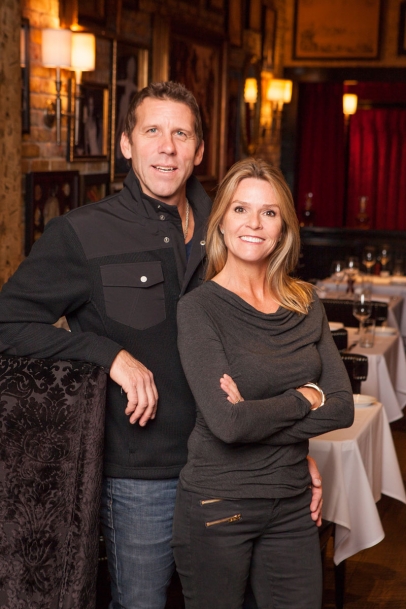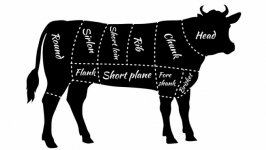Craig and Samantha Cordts-Pearce, Aspen's Restaurant Royalty
It was the evening of December 28, 2012, and Steakhouse No. 316 was firing on all cylinders, with reservations maxed out and a smooth service underway. Like all Aspen restaurants, the steakhouse depends on revenues from Christmas week to make it through the inevitably slow spring off-season, and on that December evening Craig and Samantha Cordts-Pearce—who own the steakhouse along with Aspen restaurants Brexi Brasserie, CP Burger and The Wild Fig—felt optimistic about the offseason to come.
And then disaster struck. Without warning or apparent provocation, the restaurant’s sprinkler system went off and began flooding the storage basement. Within minutes, $20,000 worth of food and supplies had been lost. It was every restaurant owner’s nightmare, and its timing couldn’t have been worse.
But rather than wring their hands or panic, the Cordts-Pearces sprang into action. They secured reservations for guests at other restaurants, closed down and over the next 24 hours redid the basement’s sprinkler system and drywall, repainted and restocked the food supply. By 5:30 p.m. the next evening they were open for business again.
That tenacious, do-it-yourself spirit has been the Cordts-Pearces’ trademark since they first opened The Wild Fig in Aspen in 2003. In the 11 years since, the couple has steered a total of eight restaurants through the choppy waters of Aspen’s notoriously tough seasonal economy, all while raising two young children.
edibleASPEN’S previous Editor Nelson Harvey spoke with them in late 2014 about choosing Aspen as a home for their restaurant empire, sourcing local food in the Rocky Mountains and the next restaurant concept up their sleeve.
edibleASPEN: The two of you met in Aspen, but then left and did stints at restaurants in New York City. After that experience, what made you decide to return to Aspen to open your first restaurant, The Wild Fig, in 2003?
Samantha: Being in the restaurant industry in New York, we just weighed the quality of life. We knew we wanted to raise a family, and working in the restaurant business in New York you work 50 weeks a year to have one week to go to the mountains and one week to go to the beach, whereas in Aspen you work really hard for six months, pretty hard for three months and then you have long periods where you can go to the city and go to the beach and travel. We figured that living here we’d be able to raise our children and spend time with them while still running restaurants, so we made the trek back.
eA: How do you divide the responsibilities of managing your four restaurants, and go about finding chefs who can execute your vision for each establishment?
S: Craig is the visionary, the big picture guy, I’m more of the worker bee handling day-to-day operations. Craig finds new spaces and negotiates the leases. The space dictates what the concept will be. For instance, Lulu Wilson (now Steakhouse No. 316) was in an 1888 mining cabin, and that wouldn’t have worked for a French brasserie but it worked great for the restaurants we opened there. Once we figure out the concept, Craig comes up with the design and he and a very small crew build out the entire space—they design the kitchen, design the restaurant, hammer every nail and put everything together.
Craig: When we opened our first restaurant, we had no extra money to hire a contractor to build our space out—I had to build it to keep the costs down. So we just learned all these other skills by absolute trial and error.
S: We always have a clear-cut idea of what our menu’s going to be, and we’ll have our chefs do tastings for us to get a handle on their skills and their creativity, and then we’ll take them on research and development trips or we’ll expose them to menus that we’ve collected from places that really excite us. We get a ton of our inspiration going to New York, and we try to expose our chefs to that.
C: We’ll actually put job postings out in cities that we respect as restaurant cities, and see what comes back to us. That way, we’ll have more of a down-home conversation with a new chef and immediately get a sense of their personality. We always put the word out in New York, San Francisco and Denver, which has really turned around and become this amazing dining city in the last 10 years.
eA: You have a diverse list of restaurants, but if there were an overarching style to the food you serve, how would you describe it?
C: We definitely have a very Old World style to what we do—I feel that our restaurants are very timeless. They’re not so modern or crazy to where they’re going to become a huge fad and then go out of style. I feel that every concept we’ve created is something that only gets better with time.
S: A lot of our food is about letting the ingredients speak for themselves, and particularly at The Wild Fig with the Mediterranean theme it’s about using spices and accompaniments that bring out the flavors of things, not trying to cover them up with fancy foams or anything like that.
eA: Over your decade-plus of running restaurants, what have your largest challenges been with incorporating local food into your dishes?
S: The lack of supply, especially in the Rocky Mountains when we have snow for nine months of the year, is an issue. The summer tourist season hits in June, but the vegetables don’t really start going off until July. At the Aspen Food & Wine Classic [in June], sometimes we’ll have chefs come and they’re excited to cook with Paonia peaches but we have to tell them that we don’t have Paonia peaches just yet! Cost is another issue: The consumer has to soak up the higher prices for local ingredients, and that’s often met with resistance even in a place like Aspen. Another issue we have is keeping a consistent menu—you put something on the menu and then a couple of weeks later it’s no longer available, or the prices fluctuate so radically that you’re, like, ‘I can’t charge $35 for a farmers’ market risotto, because no one is going to pay that much!’
eA: Aspen’s is a wickedly tough seasonal economy, and I imagine that you must have developed a few tricks of the trade to stay afloat in such an up-and-down marketplace. Can you talk about some of those?
C: I really don’t think there’s any solution to off-season. You could be the highest-grossing restaurant in Aspen, but if there are no people, there are no sales. No matter how good you are or how hard you work, most places lose money in the off-season, it’s just a question of how much you lose, and how well you manage that.
S: It’s definitely gotten better: When I first moved here there were tumbleweeds blowing through the streets and the only thing that was open was, like, Cooper Street Pier. Now there are no more tumbleweeds, and we don’t have to ever eat at Cooper Street Pier again!
eA: In your current quiver of businesses, you have a beloved Mediterranean restaurant, a classic steakhouse, a traditional French eatery and an affordable, family-friendly burger joint. What’s missing from the mix? Can you give us a hint about your next move?
C: We are definitely not finished opening up restaurants. It’s something that we make a living from, but more importantly than anything else it’s an absolute passion. I love restaurants. I love going into other people’s restaurants. It’s almost like an addiction. Let’s just say I’ve definitely been craving a really good curry. You never know what may happen.
S: There’s nothing imminent on the horizon, but our ideas are always flowing, and when the time is right and the space is right there will be something else. eA
Learn more about the Cordts-Pearces’ four Aspen restaurants and check out their menus at CPRestaurants.com.





